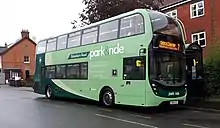Transport in Cambridge
Cambridge is a university town and the administrative centre of the county of Cambridgeshire, England. It lies in East Anglia about 50 miles (80 km) north of London. Its main transport links are the M11 road to London, the A14 east–west road and the West Anglia Main Line railway line to London.
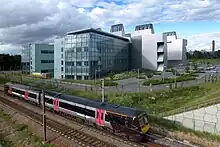
Buses
Cambridge has several bus services including routes linking five Park and Ride sites all of which operate seven days a week and are aimed at encouraging motorists to park near the city's edge.[1] Since 7 August 2011, the Cambridgeshire Guided Busway has bus services running into the centre of Cambridge.
Most buses run to and from the bus station located on Drummer Street in the heart of the city, although there are significant interchanges at the railway station and at Addenbrooke's Hospital. The principal operator is Stagecoach.
On 30 October 2022, Stagecoach cancelled 18 Cambridgeshire bus routes due to "significant falls in passenger numbers". Stagecoach has received a lot of backlash for this decision, including from the mayor of Cambridgeshire and Peterborough, Dr Nik Johnson.[2]
The Busway
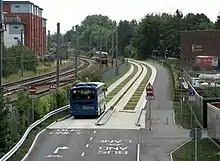
Cambridgeshire Guided Busway is the world's longest guided busway and passes through Cambridge.[3] The designated route runs on normal road from Huntingdon to St Ives, then via a bus-only guided section along the former Cambridge-St Ives railway south-east into Cambridge, where it rejoins the road at either Milton Road or Histon Road and then continues to Cambridge railway station on normal roads. From there it is again guided to Addenbrooke's Hospital and Trumpington Park and Ride.[4] An additional short spur, to Cambridge North railway station, opened in 2017.
The scheme, budgeted at £116.2 million, had been scheduled to open in early 2009[5] but did not open until August 2011.[6] The scheme had been heavily criticised by campaigners who believed that the route would be better served by restoring the previous railway route.[7]
Cambridge Park & Ride
The city is served by a seven days a week park and ride service run by Cambridgeshire County Council and Stagecoach.[8] Five sites on the outskirts of the city or just outside its boundaries – at Babraham Road, Madingley Road, Milton, Newmarket Road and Trumpington – provide over 4,500 parking spaces, electric car charging and other facilities.[9][10][11][12][13] Buses run from these sites into the city centre up to every 7 minutes.[8]
Roads
Because of its rapid growth in the 20th century, Cambridge has a congested road network.[14] Several major roads intersect at Cambridge. The M11 motorway from North-East London terminates to the north-west of the city where it joins the A14. Skirting the northern edge of Cambridge, the A14 is a major freight route which connects the port of Felixstowe on the east coast with the Midlands, North Wales, the west coast and Ireland. The A14 was often congested, particularly the section between Huntingdon and Cambridge that used to only have 2 lanes. However, the A14 upgrade scheme has attempted to address the problem, with this section now upgraded to 3 lanes in each direction, and dual 4 lanes at the Girton interchange. Cambridge is situated on the A10, a former Roman road from north London to Ely and King's Lynn. The A428 connects the city with Bedford and St Neots, and the A1303 to Newmarket and beyond to Colchester.
Some roads around the city have been designated as forming a ring road about a mile and a half in diameter, inside which there are traffic restrictions.
There are five council car parks in the city centre. There are limited numbers of metered bays offering parking for up to 1–8 hours across the city[15]
Cycling
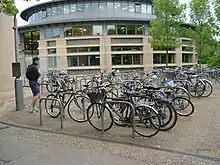
As a university town lying on fairly flat ground and with traffic congestion, Cambridge has a large number of cyclists. Many residents also prefer cycling to driving in the narrow, busy streets, giving the city the highest level of cycle use in the UK.[16] According to the 2001 census, 25% of residents travelled to work by bicycle. A few roads within the city are adapted for cycling, including separate traffic lights for cycle lanes and cycle contraflows on streets which are otherwise one-way; the city also benefits from parks which have shared use paths. There are, however, no separate cycle paths within the city centre. Despite the high levels of cycling, expenditure on cycling infrastructure is around the national average of 0.3% of the transport budget. There are a few cycle routes in the surrounding countryside and the city is now linked to the National Cycle Network. The main organisation campaigning to improve conditions for cyclists in Cambridge is the Cambridge Cycling Campaign.[17] The city was chosen as a Cycling Town by the Department for Transport in 2008, with central government funding an expansion of cycling facilities in the city and its surrounding villages.[18] There was a 5% increase in cycling from 2013 to 2014 – an increase of 88% since 2004.[19]
Bike theft in the city is a problem, with over 3000 bicycles reported stolen between April 2005 and March 2006. The actual number is believed to be higher as many thefts are not reported to the police.[20]
Rail
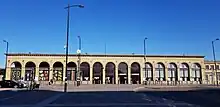
Cambridge currently has two railway stations. Cambridge railway station was built in 1845 with a platform designed to take two full-length trains, the third longest in the country. Cambridge North railway station is located in the suburb of Chesterton, close to Cambridge Science Park, and opened in May 2017. Both stations are run by Greater Anglia.
Cambridge has direct rail links to London with termini at London King's Cross (on the Hitchin-Cambridge Line and the East Coast Main Line) and Liverpool Street (on the West Anglia Main Line). There is a direct shuttle service to King's Cross every half-hour during off peak hours.[21] Peak hour trains to King's Cross have additional stops. Future developments for the Cambridge to London line include the provision of 125 miles per hour (201 km/h) high speed trains.[22] The line is currently graded for 100 miles per hour (161 km/h). The line is all welded rail, but because of the flat geography there are many level crossings, and they make it harder to run at higher speeds.
Aside from London, Cambridge is linked by rail to King's Lynn and Ely (via the Fen Line), Norwich (via the Breckland Line), Leicester, Birmingham New Street, Ipswich and Stansted Airport. The important UK rail hub of Peterborough is also less than an hour from Cambridge, which provides direct connections to Leeds, Newcastle and Edinburgh Waverley.
Cambridge south
Cambridge South, adjacent to the Cambridge Biomedical Campus, will be Cambridge's third station, and is planned to open in 2025.[23]
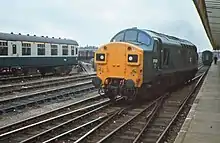
East West Rail
The railway service connecting Cambridge and Oxford, known as the Varsity Line, ceased in 1968. The East West Rail proposal plans to reinstate a direct rail route to Oxford, possibly by 2030.[24][25]
Air
The nearest passenger services are from London Stansted Airport at 28 miles (45 km) and London Luton Airport at 32 miles (51 km), Birmingham Airport at 91 miles (146 km), London Gatwick Airport at 93 miles (150 km) and London Heathrow Airport at 70 miles (113 km) all being about 90 minutes' travel, and the smaller London City Airport at 57 miles (92 km) approximately 75 minutes' travel.
The city's own airport is Cambridge Airport (formerly Marshall Airport Cambridge UK and originally Teversham Aerodrome) and is owned by Marshall Aerospace. There are no scheduled passenger services, though the runway can accommodate an unladen Boeing 747 or MD-11 and ScotAirways used to make scheduled flights to Amsterdam Schiphol Airport. The airport is used mainly by business, leisure and training flights, and to fly in aircraft for maintenance.[26][27][28] In 2004 a charter service to Jersey was operated and flights to other European destinations such as Gothenburg were operated on either a scheduled or charter basis. At the end of January 2016 all scheduled and charter flights from the airport were halted due to a lack of passenger numbers.[29]
A dealer in fibreglass-moulded light monoplanes is also based at the airport. It has been mooted to remove Marshalls to a site away from the city, and develop the land with housing.[30]
Cambridge Metro | |||||||||||||||||||||||||||||||||||||||||||||||||||||||||||||||||||||||||||||||||||||||||||
|---|---|---|---|---|---|---|---|---|---|---|---|---|---|---|---|---|---|---|---|---|---|---|---|---|---|---|---|---|---|---|---|---|---|---|---|---|---|---|---|---|---|---|---|---|---|---|---|---|---|---|---|---|---|---|---|---|---|---|---|---|---|---|---|---|---|---|---|---|---|---|---|---|---|---|---|---|---|---|---|---|---|---|---|---|---|---|---|---|---|---|---|
| |||||||||||||||||||||||||||||||||||||||||||||||||||||||||||||||||||||||||||||||||||||||||||
Past developments
 Project Cambridge developments. | |
| Location | Cambridge |
|---|---|
| Proposer | Cambridgeshire County Council |
| Status | proposed |
| Type | multi-modal |
| Cost estimate | £25 million |
Several developments to the transport system in Cambridge have been proposed by Cambridgeshire County Council.
The Holford-Wright Report
In 1950, a city plan for Cambridge was published. Chaired by Sir William Holford, an eminent architect and planner, it proposed a set of changes which a relief road for the centre of Cambridge, which would have destroyed terraced housing and other areas. These plans were, however, never implemented.[31]
Project Cambridge
In 2009 the County Council revealed its plans to spend £25 million on renovating the area from Regent Street to the Cherry Hinton Road Junction, entitled Project Cambridge. The scheme is composed of many smaller projects with common themes of making junctions easier for pedestrians to cross, promoting cycle use and reducing traffic.[32] The scheme, criticised for not having had consultation with councillors or the public,[33] is to be funded through tax increment financing where the money would initially be borrowed and would be repaid over 25 years from increases in business tax revenue. The scheme was due to be discussed by councillors in October 2009.[34]
Cambridge Gateway
The area around Cambridge railway station, was extensively redeveloped between 2010 and 2022. The station capacity was increased to match usage, and the surrounding industrial area and office blocks were replaced with flats, offices, student accommodation, 3000-space cycle park, a hotel and shops.[35][36] at an estimated cost of £3.1 million. The redevelopment of the Cambridge Station area has been given the green light and has been awarded £1.5 million of central government money to help pay for the scheme. The Hills Road Bridge safety scheme is still included in the project.
Cambridgeshire Autonomous Metro
Greater Cambridge Partnership
The Greater Cambridge Partnership (GCP) is a local delivery body for a City Deal with central government created in 2014, envisaging an investment of £500 million, mainly transport investment, over 15 years to create growth in the greater Cambridge area.[37] Its four partners are Cambridge City Council, Cambridgeshire County Council, South Cambridgeshire District Council, and the University of Cambridge.[38][37]
In February 2022, the joint assembly of the Greater Cambridge Partnership considered ideas towards shifting away from car use.[39]
In August 2022, the Greater Cambridge Partnership proposed plans for a Cambridge Sustainable Travel Zone based on a £5 congestion charge for cars and some other vehicles, coupled with £1 bus fares for single journeys to encourage use of buses.[40][41]
A consultation on proposals for the Sustainable Travel Zone ended in December 2022.[42][43]
See also
External links
- The Holford-Wright Report – report (Volume 1), maps (Volume 2).
References
- "Park & Ride". Archived from the original on 8 March 2013. Retrieved 14 October 2009. Cambridge park-and-ride
- "Mayor slams 'unacceptable' cuts as Stagecoach reveals plans to axe 18 Cambridgeshire bus routes". www.itv.com. Retrieved 7 October 2022.
- "Secretary of State Celebrates Start of Works on Guided Busway". Archived from the original on 6 June 2009. Retrieved 6 September 2009. Secretary of State Celebrates Start of Works on Guided Busway
- "Guided Busway home page". Archived from the original on 16 April 2009. Retrieved 6 September 2009. Cambridgeshire Guided Busway
- "Archived copy" (PDF). Archived from the original (PDF) on 28 May 2008. Retrieved 6 September 2009.
{{cite web}}: CS1 maint: archived copy as title (link) Guided Busway leaflet - Extance, Rachel. "Guided bus launch delayed until end of summer". Cambridge Evening News. Archived from the original on 26 May 2009. Retrieved 25 February 2009.
- "Campaigners still hope to stop the guided bus". Cambridge Evening News. 25 August 2006. Retrieved 29 October 2008.
- "Cambridge Park and Ride".
- "Babraham Road Park and Ride".
- "Madingley Road Park and Ride".
- "Milton Park and Ride".
- "Newmarket Road Park and Ride".
- "Trumpington Road Park and Ride".
- "Cambridge Futures 2 - Report". Archived from the original on 30 January 2013. Retrieved 26 March 2013.
- "Paring Meters Map". Cambridge City Council. Archived from the original on 24 September 2009. Retrieved 13 December 2009.
- http://www.statistics.gov.uk/CCI/SearchRes.asp?term=KS15&btnSubmit=Search UK Census 2001
- Cambridge Cycling Campaign
- "Cycling City, Cycling Towns". Cycling England. Archived from the original on 19 May 2009. Retrieved 13 October 2009.
- "Massive wave of cycling as tide of motorists in Cambridge held back". Cambridge News. 16 November 2015. Retrieved 16 November 2015.
- "Raids 'shockwave' for bicycle theft gangs". Cambridge Evening News. 27 July 2006.
- "First Capital Connect Train Timetables". Archived from the original on 12 February 2009. Retrieved 10 February 2009.
- "125mph trains to cut Cambridge times". Archived from the original on 26 May 2009. Retrieved 12 February 2009.
- "Government announce funding for Cambridge South station". 11 March 2020.
- "Chancellor accepts East West Rail targets and strengthens plans with extra cash". www.railtechnologymagazine.com.
- Transport Secretary officially launches East West Railway Company at Bletchley Park East West Rail, 22 November 2017
- "Archived copy". Archived from the original on 11 December 2009. Retrieved 14 October 2009.
{{cite web}}: CS1 maint: archived copy as title (link) "Cambridge Airport" - http://www.masfcambridge.com/ "Cambridge Flying Club"
- http://www.cambridgeaeroclub.co.uk/ Archived 11 December 2008 at the Wayback Machine"Cambridge Aero Club"
- Cambridge Airport axes charter and scheduled passenger flights, Cambridge News, 2 December 2015. Retrieved 2 February 2016.
- http://www.cambridge-news.co.uk/cn_business_companies/displayarticle.asp?id=148868 "At Cambridge East, centred on the airport, there are plans for 12,000 homes – if and when Marshalls relocate." Cambridge Evening News, "Shaping the Future of a Growing City", 26 June 2007 retrieved 9 August 2008
- "The Cambridge Phenomenon".
- "Project Cambridge" (PDF). Cambridgeshire County Council. September 2009. Archived from the original (PDF) on 22 February 2012. Retrieved 21 October 2009.
- "New Scheme to Improve Hills Road". 12 October 2009. Retrieved 21 October 2009.
- "£25m city scheme for cyclists and pedestrians". Cambridge Evening News. Archived from the original on 30 July 2012. Retrieved 12 January 2010.
- "Cambridge Gateway and Hills Road Safety Scheme". Archived from the original on 9 October 2010. Retrieved 13 August 2009.
- Local Transport Today, Issue 557, page 0
- Hatton, Benjamin (17 February 2021). "Cambridge transport network could be transformed by 2030". CambridgeshireLive. Retrieved 17 September 2022.
- "About GCP". Greater Cambridge Partnership. Retrieved 17 September 2022.
- Gardner, Gemma (18 February 2022). "Biggest shake-up of Cambridge road network for 40 years". Cambridge Independent. Retrieved 28 August 2022.
- Brown, Hannah (27 August 2022). "Greater Cambridge Partnership sets out plans for £5 road user charge and bus network shake-up with £1 fares". Cambridge Independent. Retrieved 28 August 2022.
- "Making Connections 2022 Project Summary". Archived from the original on 8 December 2022. Retrieved 8 December 2022.
- "Cambridge congestion charge: Will it cut queues and pollution?". BBC News. 21 December 2022. Retrieved 27 December 2022.
- Sleator, Laurence (23 December 2022). "Cambridge students clash with locals over congestion charge". The Times. Retrieved 27 December 2022.
